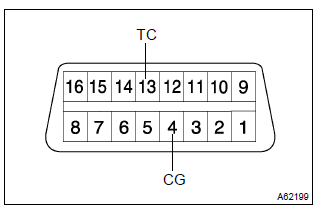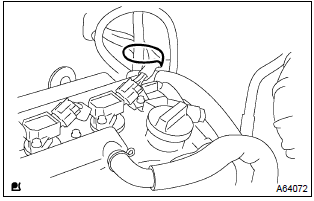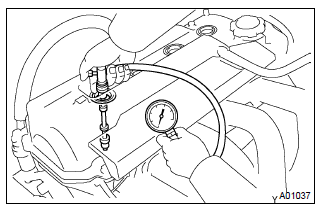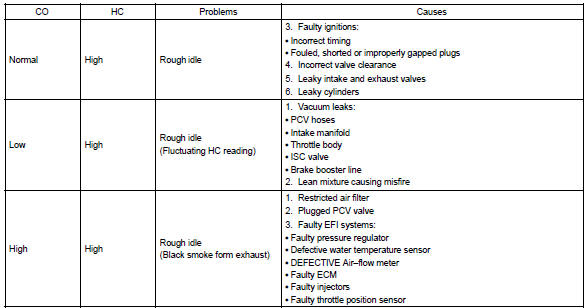Toyota Corolla (E120) 2002–2008 Repair Manual / Emission control / Engine assembly
Toyota Corolla (E120): Engine assembly
Inspection
1. Inspect coolant
2. Inspect engine oil
3. Inspect battery
4. Inspect air cleaner filter element sub–assy
5. Inspect spark plug
6. Inspect fan and generator v belt
Hint
: you don’t need to check the belt deflection because auto tensioner is adopted.
7. Inspect ignition timing
- Warm up engine.
- when using hand–held tester or obdii scan tool.
- Connect the hand–held tester or obdii scan tool to the dlc3.
Hint
: please refer to the hand–held tester or obdii scan tool operator’s manual for further details.
- when not using hand–held tester or obdii scan tool.
- Using sst, connect terminal 13 (tc) and 4 (cg) of
the dlc3.
Sst 09843–18040

Notice
:
- be sure not to connect incorrectly. It causes breakage of the engine.
- Turn off all electrical systems.
- Operate the inspection when the cooling fan motor is turned off
- remove the 2 nuts, 2 clips and cylinder head cover.
- Pull out the wire harness as shown in the illustration.
- Connect the clip of the timing light to the engine.
Notice
:
- use a timing light which can detect the first signal.
- After checking, be sure to tape the wire harness.

- Inspect ignition timing at idle.
Ignition timing: 8 – 12 btdc
N
otice
: when checking the ignition timing, the transmission is at neutral position.
Hint
: after engine rpm is kept at 1,000 – 1,300 rpm for 5 seconds, check that it returns idle speed.
- Disconnect the terminal 13 (tc) and 4 (cg) of the dlc3.
- Inspect ignition timing at idle.
Ignition timing: 10 – 18 btdc
- confirm that ignition timing moves to advanced angle side when the engine rpm is increased.
- Remove the timing light.
- Install cylinder head cover no.2 With the 2 nuts and
2 clips.
Torque: 7.0 Nvm (71 Kgf·cm, 62 in.Vlbf)
8. Inspect engine idle speed
- Warm up engine.
- when using hand–held tester or obdii scan tool.
- Connect the hand–held tester or obdii scan tool to the dlc3.
Hint
: please refer to the hand – held tester or obdii scan tool operator’s manual for further details.
- check the idle speed.
Idle speed: 650 – 750 rpm
Notice
:
- check idle speed with cooling fan off.
- Switch off all accessories and air conditioning.
9. Inspect compression

- Warm up and stop engine.
- remove ignition coil.
- remove spark plugs.
- inspect cylinder compression pressure.
Sst 09992–00500
- insert a compression gauge into the spark plug hole.
- Fully open the throttle.
- While cranking the engine, measure the compression
pressure.
Compression pressure
1,300 kpa (13.3 Kgf·cm2, 189 psi) minimum pressure: 1,000 kpa (10.2 Kgf·cm2, 145 psi) difference between each cylinder: 100 kpa (1.0 Kgf·cm2, 15 psi)
Notice
:
- always use a fully charged battery to obtain engine speed of 250 rpm or more.
- Check other cylinder’s compression pressure in the same way.
- This measurement must be done in as short a time as possible.
- If the cylinder compression in one more cylinders is low, pour a small amount of engine oil into the cylinder through the spark plug hole and repeat steps (1) through (3) for cylinders with low compression.
Hint
:
- if adding oil helps the compression, it is likely that the piston rings and/or cylinder bore are worn or damaged.
- If pressure stays low, a valve may be sticking or seating is improper, or there may be leakage past the gasket.
10. Inspect co/hc
- Start the engine.
- race engine at 2,500 rpm for approx. 180 Seconds.
- insert co/hc meter testing probe at least 40 cm (1.3 Ft) into tailpipe during idling.
- immediately check co/hc concentration at idle and/or 2,500 rpm.
Hint
:
- complete the measuring within 3 minutes.
- When doing the 2 mode (idle and 2,500 rpm) test, these measuring orders are prescribed by the applicable local regulations.
- if the co/hc concentration does not comply with regulations, troubleshoot in the order given below.
- Check heated oxygen sensor operation.
- see the table below for possible causes, and then inspect and correct the applicable causes if necessary.

Other materials:
Overhaul
1. Remove bench type rear seat cushion assy
Disengage the 2 clamps, and then remove the seat cushion.
2. Remove separate type rear seat back assy
lean the seat back forward.
remove the 2 clips.
remove the 2 bolts and seat back lh.
employ the same manner describ ...
Customization
Customizable features
Your vehicle includes a variety of electronic features that can be personalized
to suit your preferences. Programming these preferences requires specialized equipment
and may be performed by your Toyota dealer.
Customizing vehicle features
■ Changing by using the n ...
Inspection procedure
1 Check security indicator light
Set the system in 30 seconds after filliping the security indicator to
check if the alarm is triggered.
2 Check glass breakage sensor ecu (glass breakage sensor)
Check the continuity and voltage of the glass breakage
sensor ecu, as shown in th ...


